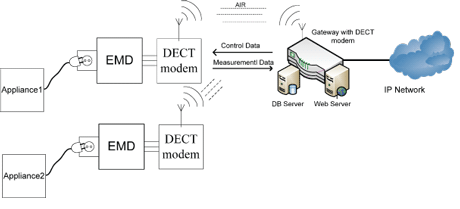by Tuan Anh Trinh and Sandor Plosz
In the framework of the AIM project (a novel architecture for modelling, virtualizing and managing the energy consumption of household appliances), an energy management system for the home enviroment is being developed [1]. The challenge is to provide communication between the user, powered devices and the energy management system. The concept of sustainable development states that we are responsible for ensuring that the environment remains as suitable for future generations as it was for us. According to measurements, the ICT industry was responsible for about 2% of global CO2 emissions in 2007, with this value projected to multiply in coming decades (SMART 2020: Enabling the low carbon economy int he information age; A report by The Climate Group on behalf of the Global eSustainability Initiative (GeSI), 2008). This issue is in large part related to the energy consumption of the devices and equipment in use. As a result, efficient energy management has recently received much attention from the ICT industry and the academic sphere alike.
Centralized energy production is becoming obsolete in consequence of the spread of methods that utilize alternative energy, which can be installed anywhere in small scale thereby making the grid more decentralized. The pressure of the principle of sustainable development is beginning to make a significant impact on the distribution of energy exploitation techniques. Most of today’s energy production and distribution systems are centralized and less managed on the consumer side, with production being based on predictions. The billing of energy is done by reading the installed watt meters manually. Energy is sold at a fixed, predetermined price based on the observed consumption. As of yet, the logic to implement energy management functions is missing in households, but achieving it would involve users in conscious decision-making through resource management and dynamic pricing. The spreading of alternative energy source exploitation in households demands more intelligence by itself. The former consumer may become a provider by investing into energy production technologies using alternative forms of energy. In order to feed energy back to the grid smart power meters are needed.
AIM is one of a number of projects investigating the issues of energy management. Some concepts have already been implemented, such as smart grids dealing with decentralized energy systems. The purpose of AIM is to create an end-to-end system for connecting the appliances into the home network in which virtualized household appliance functions and utility services are deployed under a common logic on a future ‘home gateway’. In the household, the target is to create an Energy Management Device (EMD) which can provide basic energy management functions for existing appliances and which will speed up the spread of the technology until it is standardized. Although complete logic layer structure is being defined for the inter-working of components in the system, the physical layer communication interfaces are not strictly bound, allowing manufacturers to use their desired technology.
In this work, we first investigate the option of realizing an energy management system on a DECT (Digital Enhanced Cordless Technologies) interface, and the peculiarities of DECT and new generation standards; we also examine its suitability as a communication interface in the home. We then design an EMD with basic functions and integrate it with a system connecting to the home gateway. On the home gateway we implement logic for virtualizing the functions of the EMD and hosting it for remote accessibility via a Web server. The main idea behind the EMD is on the one hand to involve the user in energy management decisions, and on the other to be able to connect the Utility (energy provider) to the home environment. The Utility has a great interest in gaining some influence, even indirectly, in the home environment.

Figure 1: General architecture of the system.
Our system provides the missing communication between the Utility, the consumer and the energy management system. The following features are available:
- monitoring of energy consumption of individual appliances with the EMD
- control of individual appliances remotely through the EMD
- energy management logic on the home gateway connecting the management systems of the home and the Utility
- real-time monitoring of the household’s consumption by the Utility.
- electricity price information request can be made to the Utility; cost of operating the appliance can be pre-calculated based on energy profiles
- resource management by the Utility; energy can be pre-bought, with price based on the reserved energy for that period
- resource optimization; the Utility can propose resource shifting for favourable prices.
Link:
http://www.ict-aim.eu
Please contact:
Tuan Anh Trinh
Budapest University of Technology and Economics, Hungary
E- mail:
Sandor Plosz
Infineon Technologies, AG
E-mail:










